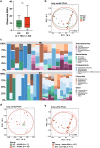Distinctive duodenal microbiomes and bile acid profiles in duodenal tumor patients revealed by prospective observational study
- PMID: 39134638
- PMCID: PMC11319767
- DOI: 10.1038/s41598-024-69820-7
Distinctive duodenal microbiomes and bile acid profiles in duodenal tumor patients revealed by prospective observational study
Abstract
The incidence of duodenal tumors (DTs) is increasing. However, the mechanisms underlying its development remain unclear. Environmental factors, including the microbiome and bile acids (BAs), are believed to influence tumor development. Therefore, we conducted a single-center, prospective, observational study to investigate the potential differences between patients with DTs and healthy controls (HCs) based on these factors. In addition, the BAs in the duodenal fluid were measured using liquid chromatography-tandem mass spectrometry. We recruited 41 patients and performed 16S rRNA-seq. There was no difference in the observed ASVs or PCoA plot of Bray-Curtis dissimilarity between the DTs and HCs. The lithocholic acid concentration was significantly lower in the DT group than in the control group. The ratio of CDCA to LCA was significantly higher in patients with DTs. No significant differences in microbiota were observed between DTs and HCs. In patients with DTs, the lithocholic acid concentration in duodenal was significantly lower than in HCs.
© 2024. The Author(s).
Conflict of interest statement
Kentaro Miyamoto is an employee of Miyarisan Pharm. Yoko Kubosawa, Tomohisa Sujino, Atsuto Kayashima, Daisuke Minezaki, Kohei Morioka, Kentaro Iwata, Kurato Miyazaki, Teppei Masunaga, Mari Mizutani, Teppei Akimoto, Yusaku Takatori, Noriko Matsuura, Atsushi Nakayama, Kaoru Takabayashi, Nobuhiro Nakamoto, Akira Honda, Motohiko Kato, Naohisa Yahagi, Takanori Kanai have no competing interests.
Figures





Similar articles
-
Altered metabolism of bile acids correlates with clinical parameters and the gut microbiota in patients with diarrhea-predominant irritable bowel syndrome.World J Gastroenterol. 2020 Dec 7;26(45):7153-7172. doi: 10.3748/wjg.v26.i45.7153. World J Gastroenterol. 2020. PMID: 33362374 Free PMC article.
-
Bile acid concentrations in serum and duodenal aspirates of healthy preterm infants: effects of gestational and postnatal age.Biol Neonate. 1997;71(4):207-14. doi: 10.1159/000244419. Biol Neonate. 1997. PMID: 9129789
-
Jiang-Tang-San-Huang pill alleviates type 2 diabetes mellitus through modulating the gut microbiota and bile acids metabolism.Phytomedicine. 2023 May;113:154733. doi: 10.1016/j.phymed.2023.154733. Epub 2023 Feb 26. Phytomedicine. 2023. PMID: 36870307
-
Duodenal bile acids as determinants of intestinal mucosal homeostasis and disease.Neurogastroenterol Motil. 2020 May;32(5):e13854. doi: 10.1111/nmo.13854. Neurogastroenterol Motil. 2020. PMID: 32323477 Review.
-
Detoxification of lithocholic acid, a toxic bile acid: relevance to drug hepatotoxicity.Drug Metab Rev. 2004 Oct;36(3-4):703-22. doi: 10.1081/dmr-200033475. Drug Metab Rev. 2004. PMID: 15554243 Review.
Cited by
-
Comparison of changes in arterial blood pressure and cardiac output during cardiogenic shock development in a porcine model.Intensive Care Med Exp. 2025 Sep 1;13(1):91. doi: 10.1186/s40635-025-00802-3. Intensive Care Med Exp. 2025. PMID: 40889089 Free PMC article.
References
-
- Qubaiah, O., Devesa, S. S., Platz, C. E., Huycke, M. M. & Dores, G. M. Small intestinal cancer: A population-based study of incidence and survival patterns in the United States, 1992 to 2006. Cancer Epidemiol. Biomarkers Prev.19, 1908–1918. 10.1158/1055-9965.Epi-10-0328 (2010). 10.1158/1055-9965.Epi-10-0328 - DOI - PMC - PubMed
Publication types
MeSH terms
Substances
Grants and funding
LinkOut - more resources
Full Text Sources
Medical
Research Materials

